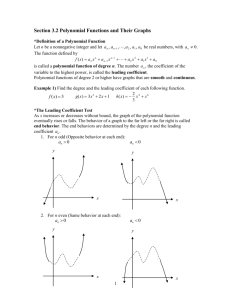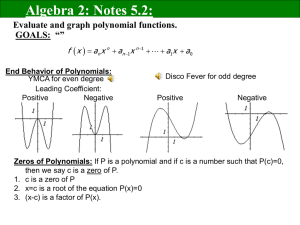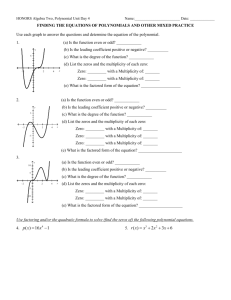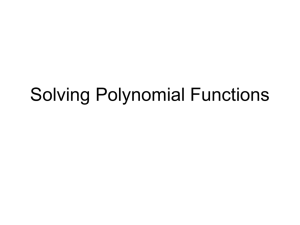6.2 Polynomials and Linear Factors
advertisement
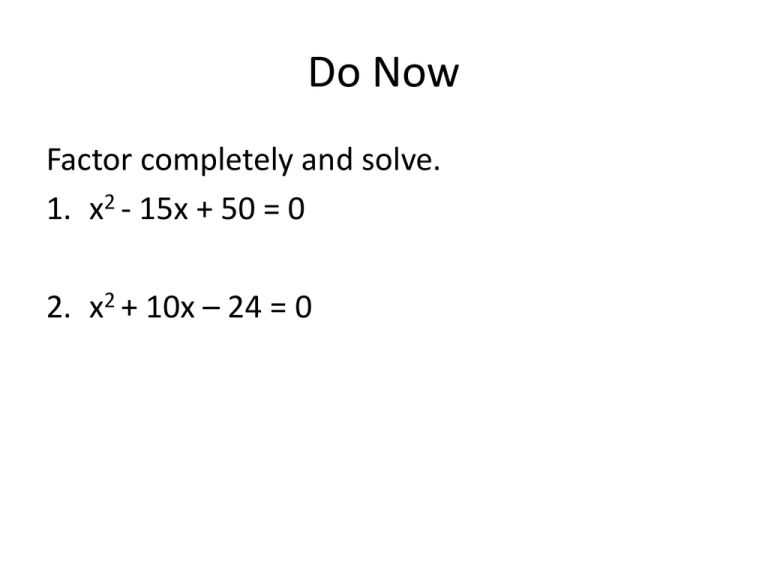
Do Now Factor completely and solve. 1. x2 - 15x + 50 = 0 2. x2 + 10x – 24 = 0 5.2 Polynomials, Linear Factors, and Zeros Learning Target: I can analyze the factored form of a polynomial and write function from its zeros Polynomials and Real Roots Relative Maximum Relative Minimum ROOTS ! • 1. 2. 3. 4. 5. 6. POLYNIOMIAL EQUIVALENTS Roots Zeros Solutions X-Intercepts Relative Maximum Relative Minimum Linear Factors Just as you can write a number into its prime factors you can write a polynomial into its linear factors. Ex. 6 into 2 & 3 x2 + 4x – 12 into (x+6)(x-2) We can also take a polynomial in factored form and rewrite it into standard form. Ex. (x+1)(x+2)(x+3) = foil distribute (x2+5x+6)(x+1)=x (x2+5x+6)+1 (x2+5x+6) = x3+6x2+11x+6 Standard form We can also use the GCF (greatest common factor) to factor a poly in standard form into its linear factors. Ex. 2x3+10x2+12x GCF is 2x so factor it out. We get 2x(x2+5x+6) now factor once more to get 2x(x+2)(x+3) Linear Factors The greatest y value of the points in a region is called the local maximum. The least y value among nearby points is called the local minimum. Theorem The expression (x - a) is a linear factor of a polynomial if and only if the value a is a zero (root) of the related polynomial function. If and only if = the theorem goes both ways If (x – a) is a factor of a polynomial, then a is a zero (solution) of the function. and Ifa is a zero (solution) of the function then (x – a) is a factor of a polynomial, Zeros • A zero is a (solution or x-intercept) to a polynomial function. • If (x – a) is a factor of a polynomial, then a is a zero (solution) of the function. • If a polynomial has a repeated solution, it has a multiple zero. • The number of repeats of a zero is called its multiplicity. A repeated zero is called a multiple zero. A multiple zero has a multiplicity equal to the number of times the zero occurs. On a graph, a double zero “bounces” off the x axis. A triple zero “flattens out” as it crosses the x axis. Write a polynomial given the roots 0, -3, 3 • • • • • Put in factored form y = (x – 0)(x + 3)(x – 3) y = (x)(x + 3)(x – 3) y = x(x² – 9) y = x³ – 9x Write a polynomial given the roots 2, -4, ½ Note that the ½ term • • • • • • Put in factored form y = (x – 2)(x + 4)(2x – 1) y = (x² + 4x – 2x – 8)(2x – 1) y = (x² + 2x – 8)(2x – 1) y = 2x³ – x² + 4x² – 2x – 16x + 8 y = 2x³ + 3x² – 18x + 8 becomes (x-1/2). We don’t like fractions, so multiply both terms by 2 to get (2x-1) Write the polynomial in factored form. Then find the roots. Y = 3x³ – 27x² + 24x • • • • • • Y = 3x³ – 27x² + 24x Y = 3x(x² – 9x + 8) Y = 3x(x – 8)(x – 1) ROOTS? 3x(x – 8)(x – 1) = 0 Roots = 0, 8, 1 FACTORED FORM What is Multiplicity? Multiplicity is when you have multiple roots that are exactly the same. We say that the multiplicity is how many duplicate roots that exist. Ex: (x-2)(x-2)(x+3) Note: two answers are x=2; therefore the multiplicity is 2 Ex: (x-1)4 (x+3) Ex: y =x(x-1)(x+3) Note: four answers are x=1; therefore the multiplicity is 4 Note: there are no repeat roots, so we say that there is no multiplicity Let’s Try One • Find any multiple zeros of f(x)=x4+6x3+8x2 and state the multiplicity Let’s Try One • Find any multiple zeros of f(x)=x4+6x3+8x2 and state the multiplicity Equivalent Statements about Polynomials -4 is a solution of x2+3x-4=0 -4 is an x-intercept of the graph of y=x2+3x-4 -4 is a zero of y=x2+3x-4 (x+4) is a factor of x2+3x-4 These all say the same thing Example 1 We can rewrite a polynomial from its zeros. Write a poly with zeros -2, 3, and 3 f(x)= (x+2)(x-3)(x-3) foil = (x+2)(x2 - 6x + 9) now distribute to get = x3 - 4x2 - 3x + 18 this function has zeros at -2,3 and 3 Polynomials and Linear Factors Write a polynomial in standard form with zeros at 2, –3, and 0. 2 –3 0 ƒ(x) = (x – 2)(x + 3)(x) Zeros Write a linear factor for each zero. = (x – 2)(x2 + 3x) Multiply (x + 3)(x). = x(x2 + 3x) – 2(x2 + 3x) Distributive Property = x3 + 3x2 – 2x2 – 6x Multiply. = x3 + x2 – 6x Simplify. The function ƒ(x) = x3 + x2 – 6x has zeros at 2, –3, and 0. Polynomials and Linear Factors Find any multiple zeros of ƒ(x) = x5 – 6x4 + 9x3 and state the multiplicity. ƒ(x) = x5 – 6x4 + 9x3 ƒ(x) = x3(x2 – 6x + 9) Factor out the GCF, x3. ƒ(x) = x3(x – 3)(x – 3) Factor x2 – 6x + 9. Since you can rewrite x3 as (x – 0)(x – 0)(x – 0), or (x – 0)3, the number 0 is a multiple zero of the function, with multiplicity 3. Since you can rewrite (x – 3)(x – 3) as (x – 3)2, the number 3 is a multiple zero of the function with multiplicity 2. Assignment #7 pg 293 7-37 odds Finding local Maximums and Minimum • Find the local maximum and minimum of x3 + 3x2 – 24x • Enter equation into calculator • Hit 2nd Trace • Choose max or min • Choose a left and right bound and tell calculator to guess
